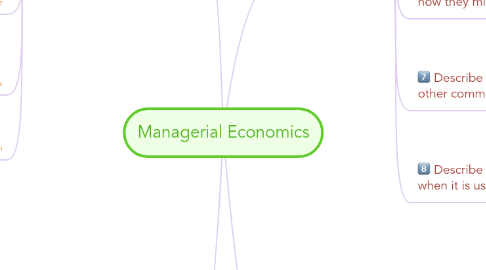
1. Firm Organisation
1.1. Serial Correlation
1.1.1. a variable that is serially correlated has a pattern, is is not random
1.2. How firms diversify & why
1.2.1. diversify into different geographies to get more work. diversify into different products to make more profit. diversify to improve economies of scale.
1.3. Procuring inputs
1.3.1. Spot Exchange; buyer & seller meet, exchange, go seperate ways. Contract; legal document creates an exteneded relationship. Produce inputs internally; produced in the firm to bypass service market
1.4. Specialised investments
1.4.1. Site specificity; buyer & seller locate together. Physical asset specificity; capital equipment designed to meet buyers needs. Dedicated assets; general investment made by firm. Human capital; specific skill set not transferable.
1.5. Franchising
1.5.1. Entrepreneur; solves branding problem. Franchise holder; solves incentive problem, principal agent problem
1.6. Decentralised organisational structure
1.6.1. several individual units in the organisation. each has responsibility for making business decisions. better information in each unit. frees management time. job satisfaction for area manager. it can be expensive to control. there could be lack of economies of scale
1.7. Functional sub units
1.7.1. grouping people reduces coordination costs but activities must be coordinated, can be effective for coordination and functional expertise is centered, provides clear promotion path. however coordination problems may happen and employees focus on micro goals
1.8. Double marginalisation problem
1.8.1. 2 monopolies in supply chain / monopoly division in firm / 2 firms selling complimentary goods.
2. Employee relations
2.1. Different employee motivations
2.1.1. money only / incentives / job satisfaction / good citizen / pride in work
2.2. assumptions of competitive labour market
2.2.1. wages determined by supply & demand / wages costless to determine / workers & jobs identical / no long term contracts / all labour hired in spot market / all compensation is monetary
2.3. principal agent problem
2.3.1. 2 parties in a firm with different incentives. how to incentive the parties to work in the interest of the firm. manager V firm owner / manager V employee
2.4. Factors hi incentive pay
2.4.1. sensitivity of output of employee effort / employee increase effort for more money / employee accept more money for less job security
2.5. Efficiency wage theory
2.5.1. efficiency wages is a relative pay between firms / when firms pay compensation higher than the market rate for a given employee / reduces staff turnover and increases staff effort
2.6. Problems with employees competing for promotion
2.6.1. undermine cooperation / peter principal / not value promotions / time spent influencing decision makers
2.7. Costs with staff turnover
2.7.1. recruitment, admin, management time / training new employees / low productivity / institutional memory loss / notice period
2.8. Costs of redundancy
2.8.1. unfair dismissal case / disgruntled employees / statutory or voluntary redundancy costs
3. Methods
3.1. Difference between normative & positive
3.1.1. Positive what people, firms and government actually do. Strictly states the facts. Normative what people, firms and government should do for effeciency. Statement expresses an evaluation.
3.2. Assumptions of standard economic model
3.2.1. individuals firms are rational, act to maximise self interest, act based on full information, have stable preferences and firms act to maximise profits
3.3. common biases
3.3.1. confirmation bias, overconfidence, framing effect, loss aversion, anchoring bias, endowment effect
3.4. Regression analysis
3.4.1. y=a+bX+e relationship between dependent variable Y and independent variable X, used to find relationship between two variables
3.5. Heuristics
3.5.1. A rule of thumb that simplify decisions. It can be described as the process of substituting a difficult decision with an easier one.
3.6. Reasons for creating econimic models, how they might be critised
3.6.1. to explain & communicate consistently, to guide data collection, to illuminate core dynamics, to bound outcomes to plausible ranges, to illuminate core uncertainties. Critised becasue the model is so complex only creator understands, there is no economic model that can be a perfect description of reality
3.7. Describe omitted variable biases & other common pitfalls
3.7.1. models of logically constructed stories and given out economic policy based on it. an advantage is it is cheap and you do not need data, common pitfalls include heavy reliance on assumptions, missing information, not enough data and data not representative
3.8. Describe QUALITATIVE research and when it is useful
3.8.1. based on interveiws, observations, case studies, gather non numerical data, uses smaller amounts of complex data, useful for addressing difficult problems, answers dependent on wording of questions, suffers from people not telling truth, used in social sciences. Qualitative useful when you want to explore what people think is happening.
4. Pricing/Costs/Profits
4.1. Changes in prices, what to expect in different markets
4.1.1. price is low = shortage of good. price is high = surplus of good. If seller drops out of market, price will rise and demand will fall. More buyers enter market, price will fall and supply will increase
4.2. Frequency price changes, why firms do not change price
4.2.1. most do not change price often, frequesnt changes antagonise customers, costs associated with changing prices, competitive pressures, costs do not change often, prices fixed by contracts
4.3. indicators of cartel
4.3.1. agreed to price or discount in a certain way. regular price changes happening in similar way, similar phrases or explainations, refusal to provide quotes outside of area, restrictions on output to reduce quantity of goods available
4.4. dominant market position
4.4.1. one service provider - similar to monopoly. high degree of market power or control over market. act without a need to consider reaction of customer or competitor.
4.5. Two part pricing
4.5.1. Fixed fee for the right to purchase the good plus a per unit charge for each unit
4.6. Commodity bundling
4.6.1. bundling several different products and selling as a package. increase prifits when consumers differ in the amounts they are willing to pay.

